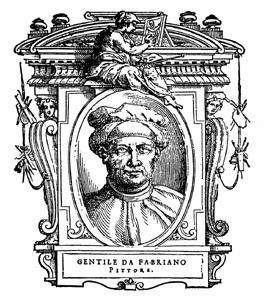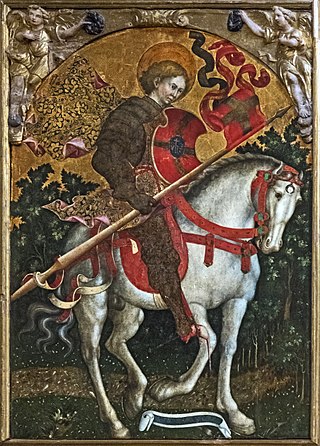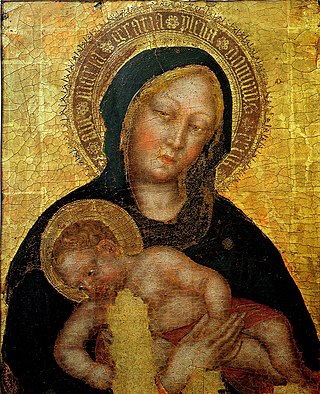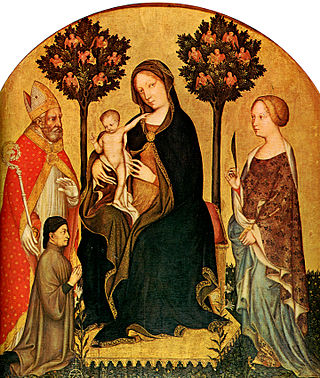See also
- Madonna and Child with Two Saints and a Donor (c.1395–1400), a tempera and gold leaf on panel painting by Gentile da Fabriano in the Gemäldegalerie, Berlin
Madonna and Child with Two Saints may refer to:

Jacopo Bellini was one of the founders of the Renaissance style of painting in Venice and northern Italy. His sons Gentile and Giovanni Bellini, and his son-in-law Andrea Mantegna, were also famous painters.

Gentile da Fabriano was an Italian painter known for his participation in the International Gothic painter style. He worked in various places in central Italy, mostly in Tuscany. His best-known works are his Adoration of the Magi from the Strozzi Altarpiece (1423), and the Flight into Egypt. Following a visit to Florence in the 1419, he came in contact with humanism, which influenced his work throughout the rest of his career. He became highly influential for other painters in Florence, especially because of his use of detail based on the observations he made of the natural world.

Pisanello, born Antonio di Puccio Pisano or Antonio di Puccio da Cereto, also erroneously called Vittore Pisano by Giorgio Vasari, was one of the most distinguished painters of the early Italian Renaissance and Quattrocento. He was acclaimed by poets such as Guarino da Verona and praised by humanists of his time, who compared him to such illustrious names as Cimabue, Phidias and Praxiteles.

Giovanni Battista Cima, also called Cima da Conegliano, was an Italian Renaissance painter, who mostly worked in Venice. He can be considered part of the Venetian school, though he was also influenced by Antonello da Messina, in the emphasis he gives to landscape backgrounds and the tranquil atmosphere of his works. Once formed his style did not change greatly. He mostly painted religious subjects, often on a small scale for homes rather than churches, but also a few, mostly small, mythological ones.

Giovanni di Paolo di Grazia was an Italian painter, working primarily in Siena, becoming a prolific painter and illustrator of manuscripts, including Dante's texts. He was one of the most important painters of the 15th century Sienese School. His early works show the influence of earlier Sienese masters, but his later style was more individual, characterized by cold, harsh colours and elongated forms. His style also took on the influence of International Gothic artists such as Gentile da Fabriano. Many of his works have an unusual dreamlike atmosphere, such as the surrealistic Miracle of St. Nicholas of Tolentino painted about 1455 and now housed in the Philadelphia Museum of Art, while his last works, particularly Last Judgment, Heaven, and Hell from about 1465 and Assumption painted in 1475, both at Pinacoteca Nazionale (Siena), are grotesque treatments of their lofty subjects. Giovanni's reputation declined after his death but was revived in the 20th century.

Michele Taddeo di Giovanni Bono, known as Giambono was an Italian painter, whose work reflected the International Gothic style with a Venetian influence. He designed the mosaics of the Birth of the Virgin and Presentation in the Temple. His best known paintings are the Man of Sorrows and the St. Peter.

The Madonna of Humility is a tempera-on-panel painting by the Italian late medieval artist Gentile da Fabriano, dating from around 1420-1423 and housed in the Museo nazionale di San Matteo, Pisa.

Madonna and Child is a tempera on panel painting of the enthroned Madonna and Child by Gentile da Fabriano. At its base are small angel musicians. It is now in the Galleria Nazionale dell'Umbria in Perugia.

The Pisa Altarpiece was a large multi-paneled altarpiece produced by Masaccio for the chapel of Saint Julian in the church of Santa Maria del Carmine in Pisa. The chapel was owned by the notary Giuliano di Colino, who commissioned the work on February 19, 1426 for the sum of 80 florins. Payment for the work was recorded on December 26 of that year. The altarpiece was dismantled and dispersed to various collections and museums in the 18th century, but an attempted reconstruction was made possible due to a detailed description of the work by Vasari in 1568.

Coronation of the Virgin is a tempera painting by the Italian artist Gentile da Fabriano, executed c. 1420, now in the Getty Museum. It originated as the front of the a processional banner - the reverse showed Saint Francis Receiving the Stigmata and is now in Parma.

Madonna and Child is a c. 1400-1405 tempera and gold leaf on panel painting by Gentile da Fabriano, now in the Pinacoteca Nazionale di Ferrara. It is signed at the base. Before being restored in 1980 it was thought to be by a follower of the artist due to thick repainting on the whole work.

Madonna and Child is the only surviving fragment of a larger tempera and gold on panel painting by Gentile da Fabriano, executed c. 1423–1425. It is now in the Berenson collection at Villa I Tatti in Settignano. It is dated to the artist's Florentine period due to stylistic similarities with the Madonnas in his Quaratesi Polyptych and Yale Madonna

Madonna and Child is a tempera and gold on panel painting by Gentile da Fabriano, executed c. 1424, now in the Yale University Art Gallery in New Haven. It is signed on the left jamb "Gent / Fabriano". Previously traditionally dated to 1420–1423, the new accepted dating is based on similarities between the background architecture and the north door of the Florence Baptistery, completed by Lorenzo Ghiberti in 1424.

Madonna and Child is a tempera and gold on panel painting by Gentile da Fabriano, executed c. 1420–1423, now in the National Gallery of Art in Washington, D.C. The work is generally identified as one of the first the artist produced in Florence, where he had arrived in summer 1420, at roughly the point at which he was working on the Pala Strozzi. It may have been the central panel of a polyptych, the rest of which is now lost.

Madonna and Child with Two Saints or Madonna and Child in Glory between Saint Francis and Saint Clare is a c.1390-1395 tempera and gold on panel painting by Gentile da Fabriano, now in the Pinacoteca Malaspina in Pavia. It is one of the earliest surviving works attributed to the artist.

Madonna and Child with Two Saints and a Donor is a c.1395-1400 tempera and gold leaf on panel painting by Gentile da Fabriano, the earliest surviving major work by the artist. Probably painted for the church of Santa Caterina in Castelvecchio in Fabriano, near to which it is now in the Gemäldegalerie in Berlin.

The Velletri Madonna is a tempera and gold on panel painting by Gentile da Fabriano, executed c. 1426-1427, the only surviving work from his stay in Rome. A Madonna of humility, it was in the church of Santi Cosma e Damiano until 1633 when Ludovico Ciotti di San Paolo, General of the Third Order Franciscans, donated it to the Church of Sant'Apollonia in Velletri. It is now in the Diocesan Museum in Velletri. A restoration in 1912 restored the top to its original triangular form.

Madonna and Child Enthroned with Two Angels is a c.1410-1415 tempera and gold on panel painting by Gentile da Fabriano. Its original provenance is unknown, though its small size probably means it was made for private devotion. It is first recorded in the early 20th century, when it was in the Casa Persicini in Belluno, which suggests it links to the painter's time in Venice. It is now in the Philbrook Art Center in Tulsa, Oklahoma.

Madonna and Child with Saints Julian and Lawrence is a c. 1423–1425 tempera and gold leaf on panel painting by Gentile da Fabriano. It is now in the Frick Collection in New York. To the left is saint Lawrence in a deacon's dalmatic and holding the gridiron of his martyrdom, whilst to the right is Saint Julian.

The Intercession Altarpiece is a five-panel tempera and gold on panel painting by Gentile da Fabriano, produced during his stay in Florence from 1420 to 1423. Its original location is unknown, though it is now in the sacristy of Chiesa di San Niccolò Oltrarno in Florence. It is named after its central panel of Jesus and the Virgin Mary interceding to God the Father. The two outermost panels show Louis of Toulouse and Bernard of Clairvaux. The two inner side-panels show the Resurrection of Lazarus and a group of three saints.